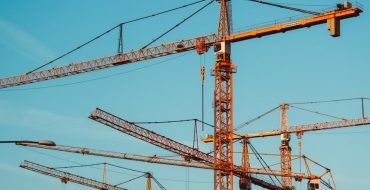Dive Brief:
- Rider Levett Bucknall’s Crane Count decreased by 4.5% from Q1 to Q3 2021. The index measures the number of fixed cranes across cities in the U.S. and Canada, as a representation of the active construction workload in those cities.
- Of the 14 cities measured, only three — Los Angeles, San Francisco and Toronto — saw an increase in the number of cranes in that period.
- Five of the cities — Chicago, Denver, Las Vegas, Phoenix and Portland — saw what RLB called a “significant decrease” in the number of cranes; dropping by 30% or more.
Dive Insight:
The dip in Q3 comes after a spike in Q1 of 2021, which also followed a decrease in the crane count. Toronto has continued to tower over U.S. cities when it comes to the total number of cranes.
One thing connects all the cities, RLB’s report said: uncertainty, which remains significant to construction everywhere. Commercial cranes are down collectively 36% — or 20 cranes — across North American cities.
“We anticipate better times ahead with previously delayed projects being brought back online,” the report said. “However, this is conditional upon market conditions as the AEC industry continues to experience the effects of COVID-19.”
The most popular sectors for crane usage were mixed-use and residential. In Los Angeles, RLB counted 25 cranes for mixed-use and 12 for residential projects. In Toronto, those numbers were 47 and 133, respectively.
Other findings from the report include:
- A 40% increase of cranes used in the education construction sector.
- Los Angeles saw the highest percentage increase from Q1 to Q3, by 19%.
- The number of cranes in Toronto increased by 81% when compared to Q3 2020.
Here are some of the highlights for U.S. cities:
Los Angeles: The second most populous city in the U.S. saw its second straight report with an increase in the number of cranes, jumping from 43 to 51. The growth can likely be attributed to an increase in major transportation projects in the city, RLB said. The number of cranes on commercial projects have declined, in addition to a dip in the hospitality sector, but there has been a spike in demand for residential construction.
San Francisco: The number of cranes in San Francisco grew by two from Q1 to Q3, but 10 new cranes have been erected within the last six months, RLB said, as some projects leave and others arrive. Most of the new cranes are for residential projects, which has seen an increase in demand, though others are for mixed-use and industrial projects.
Chicago: In January of 2017, RLB counted 56 cranes in Chicago. A steady, though not constant, decline in those numbers led to only seven counted cranes in Q3 of 2021. This, however, is due to a large number of projects downtown topping off and now leasing to new renters. The number of cranes is not anticipated to increase in the near future, RLB reported.

